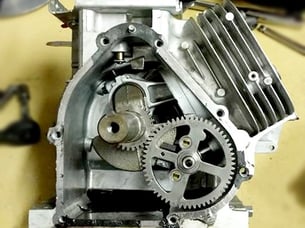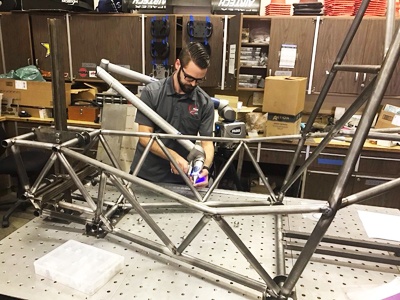
California State University, Fullerton's SAE (Society of Engineers) Baja is off to the races with a brand new car to dominate the rugged terrain of this year's International competition track in Oregon. Engineering students from CSUF are not only faced with the task of designing and building a "single-seat, all-terrain sporting vehicle that is to be a prototype for a reliable maintainable, ergonomic, and economic production vehicle that serves the recreational user market," but they must do so while also balancing their daily classes, and for some, their jobs as well. Given such a limited amount of time to build a winning vehicle, there is even less room to spend correcting any build errors. Therefore, quality must be built into each vehicle that the SAE Baja Team designs and manufactures, and Q-PLUS Labs provides them the measurement data they need to confidently drive to victory.
Introduction
 Every year, a new team assembles for this legacy project where current class seniors pass on their knowledge to upcoming juniors who will in turn pass that knowledge to their lower classmen. This through the process of raising funds to acquire the components to build the vehicle to "exposure with recruiters from leading companies in the mobility industry to help land their first engineering job after graduation." Each car starts from a design concept that has been modified over the past years of competition, however each new competition requires a new car to be built from the ground up. With each competition, the students face the time consuming and challenging process of designing the car, building the chassis, welding, and various test runs.
Every year, a new team assembles for this legacy project where current class seniors pass on their knowledge to upcoming juniors who will in turn pass that knowledge to their lower classmen. This through the process of raising funds to acquire the components to build the vehicle to "exposure with recruiters from leading companies in the mobility industry to help land their first engineering job after graduation." Each car starts from a design concept that has been modified over the past years of competition, however each new competition requires a new car to be built from the ground up. With each competition, the students face the time consuming and challenging process of designing the car, building the chassis, welding, and various test runs.
Our Process
 The team's model this year is named after the mascot of California State University, Fullerton – Tuffy the Titan. The overall design for chassis is consistent with the team's past models, however the significant change this year will be the design of the gearbox. Unlike the previous models, this year's model features a smaller gearbox which consequently decreases the length from the input to the output shaft. This will also push the firewall further back and allow more leg room for the driver, which is important when driving on challenging terrain during the competition's four hour endurance course. CSUF's Baja Team approached Q-PLUS Labs to obtain measurement data for their chassis design. Using a FARO arm, Q-PLUS Labs was able to articulate the probe between the areas of the chassis to collect data on the car's body. Accurate measurements will help enable CSUF to confidently move forward with manufacturing the components dependent on these measurements, ensuring that their time is focused on the success of the California State University, Fullerton's SAE Baja team in their race this on May 30th-June 2nd.
The team's model this year is named after the mascot of California State University, Fullerton – Tuffy the Titan. The overall design for chassis is consistent with the team's past models, however the significant change this year will be the design of the gearbox. Unlike the previous models, this year's model features a smaller gearbox which consequently decreases the length from the input to the output shaft. This will also push the firewall further back and allow more leg room for the driver, which is important when driving on challenging terrain during the competition's four hour endurance course. CSUF's Baja Team approached Q-PLUS Labs to obtain measurement data for their chassis design. Using a FARO arm, Q-PLUS Labs was able to articulate the probe between the areas of the chassis to collect data on the car's body. Accurate measurements will help enable CSUF to confidently move forward with manufacturing the components dependent on these measurements, ensuring that their time is focused on the success of the California State University, Fullerton's SAE Baja team in their race this on May 30th-June 2nd.





